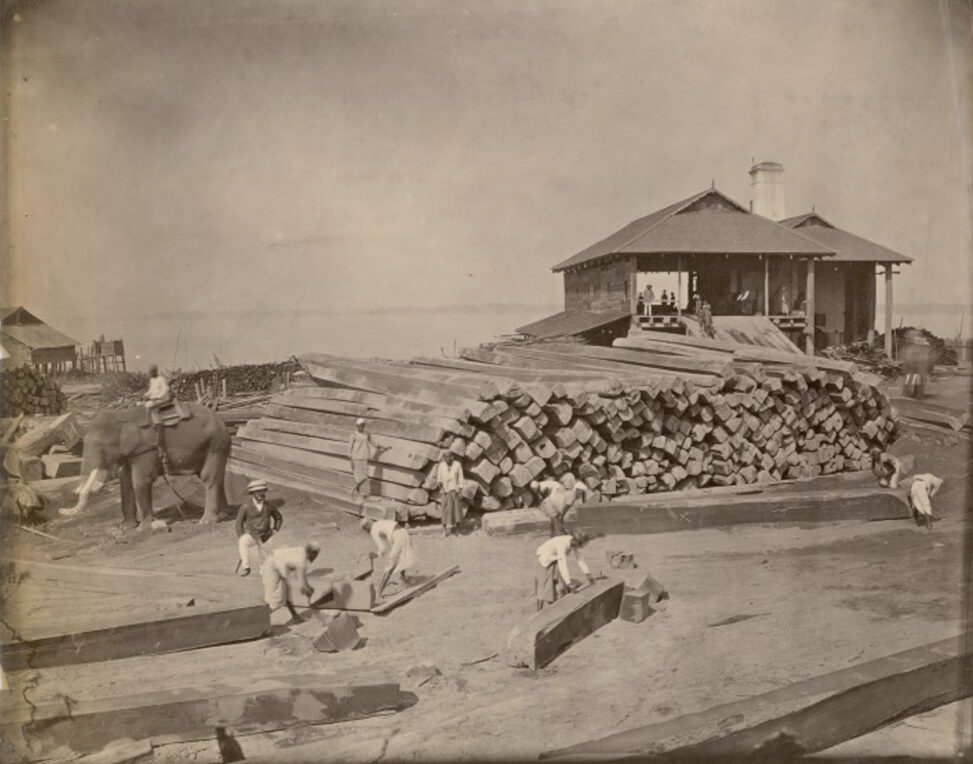Title: Elephant Moving Timber In Moulmein
Date Created: 1885/1895
Abstract: A photograph of a lumber yard in Mawlamyine (previously Moulmein), Myanmar (Burma) with various piles of lumber, men working in the yard, and two elephants being used to move lumber. The image shows British officials (potentially soldiers) overlooking the Burmese individuals working. There are two buildings in the background of the photograph as well as a body of water in the distance. The title is written on the back of the photograph.
Elephant Moving Timber In Moulmein
The first thing that I noticed about this photo was all the timber that is laid out. The next thing that I noticed was the water in the background. And the last thing that I noticed without really looking at the picture was the elephant. Right after I saw the elephant in the photo I noticed the person riding it with a saddle with a rope tied to the elephant. The timber is also very long and thick which I would believe is very hard to move and also very time consuming. If you look closely you can see that all those in the picture are not wearing shoes. I personally don’t know if there is a reason for this or if they just didn’t have shoes back then that were just available to them. The picture was taken between 1885/1895. One of the big things that was going on in Southeast Asia during this time period was globalization trading. This is significant because still today Southeast Asia is a big part of the world’s manufacturing and trade. Those who work with these elephants are probably affected by all the trade in Southeast Asia even in today’s day.
One of the connections between the picture I chose and what we have learned in class is how a lot of the pictures are just the scenery of Southeast Asia. I feel like they do a really good job at showing just how little they have to live off of. This is especially shown in the early Southeast Asia days. When looking at the physical copies of these photographs in the library my group talked about how one of the books was just landscape pictures and nothing else. This goes to show just how much our earth has grown and evolved. It’s crazy to think that we use so much more lumber for everything today but back then it was a lot less in demand. It’s also interesting to think about how much timber costs in today’s world and how different it was back then. There used to be so much open free land and now it’s all covered by this timber that these elephants had to transport to and from different places.
Back to the elephant’s and how they’re used, “Myanmar has the world’s largest captive elephant population, and the vast majority of them still work as timber elephants”(Hausheer). The thought of these poor elephants being held captive and only being used for labor is upsetting. I understand the need for something strong to be able to move all the heavy timber and how the most readily available thing back in the day before heavy machinery was elephants. I would be really interested to see how time efficient the elephants were back in the day. I think the machines would definitely be more efficient now but not necessarily healthy for our environment.
One of the other things I noticed in the picture is how the building in the background only has a roof and two walls. The front wall and back wall are not there. There’s a ramp on the front of the building but you can’t see what’s on the back side. I don’t know exactly what the significance to this is but it could potentially just be for the workers or to store something related to the lumber. There also looks like there could be a little house connected to the building because of the chimney that’s coming out of the top of the roof. In the back of the picture you can see a big body of water, which is why I’m not sure what’s on the backside of the open side of the building.
The wood that is shown in the picture is most likely Teak. This kind of wood is indigenous to Myanmar. “Myanmar teak is highly valued for its durability, water resistance, and resistance to termites”(Yadav). This makes teak wood in very high demand and means that there’s lots to move constantly to different parts of Myanmar and all over the world. The wood is used to make furniture, decking, and even luxury yacht pieces. With every tree cut down the forests are getting smaller and smaller and this is not good for the environment. With all of this happening the price of the teak wood rises to crazy prices, but yet the demand is still there.
This picture has a lot within, it shows how much our techniques have changed for such similar work. Even years later we are moving timber, but we are no longer putting innocent elephants’ lives at stake.
Work Cited
“Early Photography of Asia .” Early Photography of Asia, n.d., https://cudl.colorado.edu/luna/servlet/CUB~34~34?cic=CUB~34~34.
Hausheer, Justine E. “Saving Myanmar’s Timber Elephants.” Cool Green Science, 26 Jan. 2023, https://blog.nature.org/2018/07/16/saving-myanmars-timber-elephants/.
The day we went to the library and looked at the physical copies of the picture online.
Yadav, Pooja. “Explained: Why Teak Imported from Myanmar Is Called ‘Conflict Wood.’” IndiaTimes, 12 Mar. 2023, https://www.indiatimes.com/explainers/news/explained-why-teak-imported-from-myanmar-is-called-conflict-wood-595202.html.
